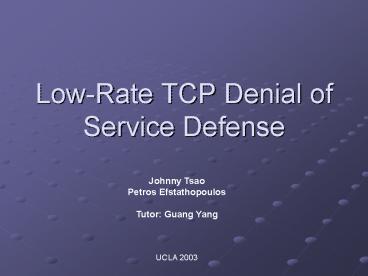LowRate TCP Denial of Service Defense - PowerPoint PPT Presentation
1 / 24
Title:
LowRate TCP Denial of Service Defense
Description:
Low-Rate TCP Denial of Service Defense. Johnny Tsao. Petros Efstathopoulos. Tutor: Guang Yang ... Floods bottleneck with packets to overflow queues and produce ... – PowerPoint PPT presentation
Number of Views:89
Avg rating:3.0/5.0
Title: LowRate TCP Denial of Service Defense
1
Low-Rate TCP Denial of Service Defense
Johnny Tsao Petros Efstathopoulos Tutor Guang
Yang UCLA 2003
2
What is a Low-Rate DoS Attack?
- Floods bottleneck with packets to overflow queues
and produce dropped packets - TCP connections senses congestion and waits
retransmission timeout (one second) - While TCP connections are waiting the timeout,
the attacker does not need to attack - It then resumes attacking after waiting the RTO
- The attacker has a low throughput relative to
traditional DoS attackers so it can avoid
detection
3
Proposed Solution
- Randomize the RTO so that we start retransmitting
in between attacks - This should help improve throughput
- Various possible randomization techniques
simulations show that choice doesnt make
significant difference
4
Related Works
- A. Kuzmanovic and E. W. Knightly, Low-Rate
TCP-Targeted Denial of Service Attacks (The Shrew
vs. the Mice and Elephants), In Proceedings of
ACM SIGCOMM 2003, Karlsruhe, Germany, Aug. 2003 - G.Yang, M.Gerla and Y.Sanadidi, Randomization and
Probing Defense against Low-rate TCP-targeted
DoS Attacks, UCLA Computer Science Department,
Internal Draft - These papers run simulations only, we will test
their findings with experiments
5
Our Task
- Analyze the effectiveness of randomized RTO
against a low-rate TCP DoS attack - Evaluate effectiveness by performing experiments
on a TCP testbed using DummyNet to simulate an
internet bottleneck - Compare experimental results to simulation results
6
The Linux Kernel
- Linux implements TCP New Reno
- The Linux kernel actually uses a minimum RTO of
200ms (max is 120sec) - This reduces the effectiveness of a low-rate
attack since it must transmit more often, leaving
it more susceptible to detection
7
The Linux Kernel (cont)
- Linux uses the value of RTOmin to initialize the
value of rttvar when a new connection is
establised - Setting RTOmin to 1sec heavily affected rttvar
- Solution bound the value of RTO dynamically
without changing the defined values that affect
rttvar
8
Linux Kernel Modifications
- Kernel 1 make minimum RTO 1sec in order to
match the papers by Knightly and Yang - Kernel 2 Randomize RTO around 1sec to see if
randomization can defend against a low rate attack
9
Experiment Setup
- Sender, Receiver
- - iperf client and server to produce TCP traffic
- Attacker
- - Custom UDP traffic generator 3MBit/s attack,
50 byte packets - DummyNet simulates internet bottleneck
- - 1.5MBit/s link
- - 40ms propagation delay
- - 50 slot queue
10
The Square Wave Attack(approximates a Low-rate
TCP DoS Attack)
Burst Length
Inter-burst Period
11
Experiments
- 4 sets of experiments
- Set 1 standard Linux kernel behavior
- Set 2 modified 1sec Linux kernel behavior
- Set 3 modified 1sec randomized RTO Linux
kernel behavior - For each set we measured throughput for
interburst periods (IBPs) ranging from 0.3sec to
5sec (burst length and network parameters were
kept constant) - Set 4 all kernels measured under attack for
different burst lengths
12
Topology
13
Attack
14
Experimental Results I
- The standard Linux kernel is vulnerable, but a
high rate attack is needed (minRTO is 200ms)
15
Experimental Results II
- Changing the minimum value of RTO to 1sec makes
the attack very effective!
16
Experimental Results III
- Randomizing the value of RTO in the 1sec kernel
(randomization ranges from -0.5 to 0.5)
significantly improves performance (connection
NOT throttled for IBPs of 0.5s and 1s)
17
Experimental Results IV
- Randomization eliminates the throughput
throttling problem for IBP values of minRTO/2 and
minRTO - Experimental results confirm simulation results
18
Experimental Results V
- The burst length greatly affects the
effectiveness of the attack
19
Experimental Results V (cont.)
20
Our Findings
- Low-Rate TCP DoS attack relies heavily on RTO
synchronization - Attack targets low RTT connections
- Randomization of RTO improves throughput greatly
(especially in the vulnerable cases of 0.5s and
1s)
21
Our Findings - II
- The effectiveness of the attack depends a lot on
the synchronization of the sender and the
attacker - Performance results for certain cases fluctuated
greatly for consecutive runs of the same
experiment. Possible reasons Dummynet buffer
management, synchronization issues between the
attacker and the sender
22
Conclusions
- The experimental results coincide with the
findings of papers by Knightly and Yang - Randomization is an effective way to reduce the
damage done by a Low-Rate TCP DoS attack - Such an attack may not be realistic if modern
systems implement a low RTO - (ie. Linuxs 200ms RTO)
23
Future Work
- Determine the fairness of the RTO randomization
scheme - Explore probing as a defense against a Low Rate
TCP DoS attack - Examine the attack and defense results with
multiple TCP flows
24
References
- A. Kuzmanovic and E. W. Knightly, Low-Rate
TCP-Targeted Denial of Service Attacks (The Shrew
vs. the Mice and Elephants), In Proceedings of
ACM SIGCOMM 2003, Karlsruhe, Germany, Aug. 2003 - G.Yang, M.Gerla and Y.Sanadidi, Randomization and
Probing Defense against Low-rate TCP-targeted
DoS Attacks, UCLA Computer Science Department,
Internal Draft - Pasi Sarolathi, Alexey Kuznetsov, Congestion
Control in Linux TCP - D. Bovet and M. Cesati, Understanding the Linux
kernel, OReilly press 2003

